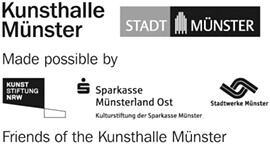Devotional Document (Part 2)
May 27–October 1, 2017
Hafenweg 28, 5th floor
48155 Münster
Germany
Hours: Tuesday–Sunday 12–6pm
T +49 251 4924191
kunsthalle@stadt-muenster.de
Wu Tsang (*1982, USA) is one of the highest-profile performers, artists and filmmakers of her generation. For her first institutional solo exhibition in Germany, Wu Tsang has realised a new installation-based spatial production with films and performative sculptural elements in the Kunsthalle Münster. Devotional Document (Part 2) diversely addresses the issue of identity and the (im)possibility of interpersonal relationships within their social and political entanglements through a sensory and physical experience using language, sound, motion and touch.
With a high level of scepticism concerning the representative power of images, Wu Tsang’s sculptures and installations search for pictorial concepts that appear both unattainable and impossible and that are consistently destabilised along the axis between alluring beauty and repellent irritation. Wu Tsang uses languages and forms of expression for this purpose that often negate any contemporary notions and frequently lack any form of independence. On the one hand they utilise the narrative of the past that in their re-appropriation accommodate the potential of misunderstanding and erroneous interpretation, and on the other they reside in a near future, the narratives of which remain open, are not predictable and cannot be controlled. Wu Tsang also often works with other male/female artists, performers and theorists, integrating their highly diverse opinions, positions and voices to an equal extent.
The works resulting from this deliver fictions that however not only provide imaginary worlds conflicting with reality. They rather subtitle and duplicate reality without deleting it, as well as exposing another method of access to this. Such works shift the coordinates of what can be represented as well as the perception of sensory events and how we relate these to ourselves. In their diversely designed, polyphonic and contrarily circling juxtapositions they permit the contradiction of the incompatible as a form of possibility and oppose our contemporary longing for completeness, perfection and association – and also because they are mostly conceived as performances where the works of art are produced in new ways with each often physically interacting with the observers. Via the paths of language and movement they simultaneously develop the practice of refuting, concealing, tricking and misdirecting that in turn enables access to oneself to succumb to the inherent transparency of people as random human capital; they also pretend to be something they possibly are not.
Wu Tsang tells stories full of affected sentimentality, the emotional truth of which is located at the porous limits of our collective memory, individual life plans and imagination—documentary fictions with sociopolitical dimensions and a magical realism that appeals equally to our experience and imagination. They affect us directly in a sensory way and hit us severely where we are fragile: with relation to the construction of our own identity and at the empty space between our isolated self and its connection with others in the periphery. Wu Tsang is dedicated to addressing this empty space in performance, the blurred intermediate void, the location where incompatible perspectives and the contingent sense set up an illusion of the social sphere as a brittle, makeshift field.
Using multi-media and ever-new combinations, her productions create a poetic of intimacy with a subversive plea for ongoing disidentification that denies the utilisation and exploitation of others as a completion of the self und to conceal our own transparency and readability.
To fail to gain self-assurance over others or refute any insights or awareness of the other, but to feel the other and simultaneously to be next to oneself would be both an affirmation and an improvisation of our shared fragility. Here and here only are we presented with the chance of an abrupt, direct social environment. Such a social environment would not mean mutual disappropriation, but a reclassification of parallel existences that no longer distinguishes between inner and outer entities, me and you or black and white…
The exhibition is curated by Gail Kirkpatrick and Marcus Lütkemeyer.



